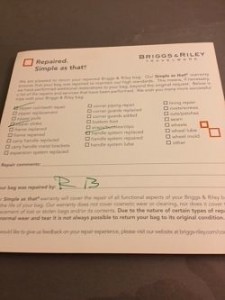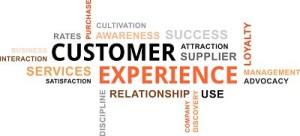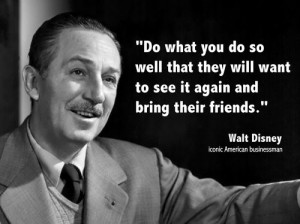August 1, 2013

My Briggs & Riley bag
Want a great brand? Building a great brand means going the extra mile. Let me give you an example.
I travel a lot so I decided it was time to invest in a suitcase that could take the beating that 100+ flights a year dishes out without having to be replaced every year. So after doing more research than a suitcase purchase should require, I spent a ridiculous amount of money on a Briggs & Riley suitcase.
Keep in mind, I’m usually a run to Target and buy a bag kind of guy. So this was a big money decision for me.
I made the investment because the bag is guaranteed for life. Here’s how they talk about their guarantee:
If your Briggs & Riley bag is ever broken or damaged, even if it was caused by an airline, we will repair it free of charge – Simple as that! Here’s how the Briggs & Riley Simple as that® guarantee works:
A. Simple bag repairs – you can send or bring your bag to a local Authorized Repair Center. No repair number is needed. Please note that you are responsible for any freight charges incurred when shipping your bag to an authorized repair center.
B. Badly damaged bags – we recommend sending them directly to Briggs & Riley at one of our Official Company Repair Centers.
Our ‘Simple as That®’ guarantee will cover the repair of all functional aspects of your Briggs & Riley bag for life.
In my mind, that meant:
- It would last a really, really long time before anything broke, ripped or didn’t work
- It would be easy to get it fixed, if I ever had to
- These people really care about their customers
I love the bag. It’s easy to pack an entire week’s worth of stuff into, if I need to. Shirts and sports coats travel well and come out pretty wrinkle free. So I’m happy.
![photo[2]_opt](/images/2013/07/photo2_opt.jpg) Fast forward to 10 months after the purchase. The bag has a rip in it.
Fast forward to 10 months after the purchase. The bag has a rip in it.
So I go to the B&R website and complete a form. It’s relatively painless (who knew a suitcase could have a serial number?) and I submit it. Unfortunately, because there were no authorized repair centers in my area, I had to send my bag back to Briggs & Riley.
The email telling me this gave me all the information I needed but didn’t express any sentiment or apology for the fact that I was going to be inconvenienced.
I had to take the bag to a UPS store because really — who has a box big enough for a large suitcase laying around. By the time I bought the box and paid for the shipping, it was close to $100. Lovely.
 Then, I waited. And waited. I didn’t hear anything from Briggs & Riley. It had been a few weeks and I was just about to reach out to them via their website when voila, my repaired suitcase arrived with this card that outlines what got fixed. And that’s it.
Then, I waited. And waited. I didn’t hear anything from Briggs & Riley. It had been a few weeks and I was just about to reach out to them via their website when voila, my repaired suitcase arrived with this card that outlines what got fixed. And that’s it.
So let’s review.
- Briggs & Riley makes expensive and well crafted bags
- They guarantee the bag for life and will repair the bag for free
- They make it simple to get the bag repaired
- They honored their promise — fixed my bag and sent it back to me
So they follow all the best business practices. They make a quality product and charge a premium for it. They back their product with a rock solid guarantee and then they honored that guarantee.
They did it all right. And yet….they screwed it up at every turn. They had so many opportunities to build a bond and their brand and they whizzed by every one of them.
When someone pays a ridiculous amount of money for something you sell — they want to be reassured that they made a good call. they want to be your fan. Let me say that again — they want to be your fan. But you have to extend the invitation and make the effort.
If I was the Director of Marketing for Briggs & Riley, here’s what I would do different:
- When someone buys one of our bags and registers it (with the serial # etc) I would send them a hand signed thank you note from the CEO/President, welcoming them into the B&R family and inviting them to join our customer exclusive club
- Our club would offer travel tips for the seasoned road warrior, packing tips etc.
- Every holiday season, we’d send a small gift (like B&R luggage tags) to the members of our club.
- If someone came to our website to report a damaged bag, we’d have them fill out the form but the email confirmation/reply would outline what they should expect, in terms of time frame etc. It would also offer a sincere apology that they have to be inconvenienced by not having their bag.
- We’d have a suitcase loaner program. No one spends that kind of money on a suitcase unless they travel a lot. We’d offer to ship them a clean, used bag to use while theirs is in our shop. All they’d have to do is pay to ship it back. (I doubt very many people would accept this offer…but the gesture matters)
- When their bag arrived at our repair center, we’d notify them that it had arrived and give them an estimated date for the return of their bag.
- Sometime during the repair timeframe, we’d send them a funny video about their bag recovering from its surgery and as soon as it was released…it was headed back home.
- In the box with the returned bag, we’d send them a thank you note from the repair team, thanking them for their confidence in Briggs & Riley and apologizing again for the hassle.
- In 30 days after the bag was returned — they’d get a letter from us, asking if the bag is now performing to Briggs & Riley standards.
Most of those ideas wouldn’t cost very much money. But each one would get one step closer to creating a brand zealot — someone who raves about their bag and convinces other people to buy one too.
Building a brand doesn’t have to cost a fortune. It’s about doing what’s right and then asking yourself — what else could we or should we do? And then doing it. That’s how you create a love affair with your customers.
Don’t rest on your great product. In today’s hyper competitive world, you have to do a lot better than that.
More
 I’ve never met a business owner or leader who didn’t want the employees of their organization to deliver excellence. And the truth is – most employees want that too. They want to work for an organization that allows and even encourages them to go above and beyond for the people they serve.
I’ve never met a business owner or leader who didn’t want the employees of their organization to deliver excellence. And the truth is – most employees want that too. They want to work for an organization that allows and even encourages them to go above and beyond for the people they serve.






![photo[2]_opt](/images/2013/07/photo2_opt.jpg) Fast forward to 10 months after the purchase. The bag has a rip in it.
Fast forward to 10 months after the purchase. The bag has a rip in it. Then, I waited. And waited. I didn’t hear anything from Briggs & Riley. It had been a few weeks and I was just about to reach out to them via their website when voila, my repaired suitcase arrived with this card that outlines what got fixed. And that’s it.
Then, I waited. And waited. I didn’t hear anything from Briggs & Riley. It had been a few weeks and I was just about to reach out to them via their website when voila, my repaired suitcase arrived with this card that outlines what got fixed. And that’s it.